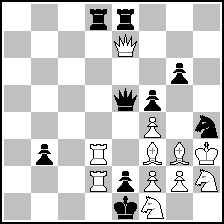|
|
| (1) Posted by Hauke Reddmann [Tuesday, Mar 1, 2022 10:18] |
Pseudo Motive Inversion in the n#
 (= 11+9 ) (= 11+9 )
#2v (HR, Schwalbe 2009)
Observe 1.Se3? (2.Rxe2) Qb2! 2.Rd1??
White closes the e line, Black refutes because of the closure of the e line...
of course I cheated. The motive is NOT identical.
Do you have some more examples? (#2 preferred)
|
|
| (2) Posted by seetharaman kalyan [Wednesday, Mar 2, 2022 05:16] |
Why do you say that motive inversion is not identical? Not clear
|
|
| (3) Posted by Dmitri Turevski [Wednesday, Mar 2, 2022 08:42] |
@Seetharaman
Strictly speaking, e5-e2 and e7-e1 are not the same line
|
|
| (4) Posted by Hauke Reddmann [Wednesday, Mar 2, 2022 11:06] |
@Seetharaman: Even more, one is a white and
one a black line! Litmus test: Imagine White could close
the line only for the bQ, but the white piece is
"air" for the wQ. Qb2 no longer defends. Thus
the line is shared, but not the *motive*.
|
|
| (5) Posted by Hauke Reddmann [Wednesday, Mar 2, 2022 11:13] |
As usual (cf. also https://www.matplus.net/start.php?px=1646215779&app=forum&act=posts&fid=gen&tid=2478) stalemate is the only way to justify it in the orthodox genre.
Challenge: Black defense is that the white mating sequence now
only stalemates, say by line opening. White uses the taken K flight
for another mate. (I think only possible in >2#.)
|
|
No more posts |
MatPlus.Net  Forum Forum  General General  Pseudo Motive Inversion in the n# Pseudo Motive Inversion in the n# |
 ISC 2024
ISC 2024 Forum
Forum  General
General  Pseudo Motive Inversion in the n#
Pseudo Motive Inversion in the n# 


